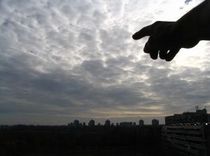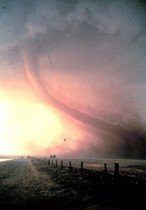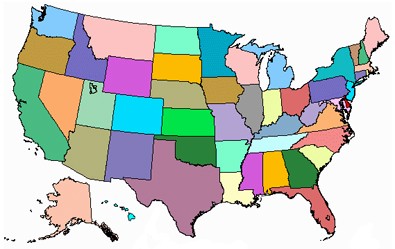 You’ve seen storm chasers and weather spotters featured on the local and national news. Plenty of times, right?
You’ve seen storm chasers and weather spotters featured on the local and national news. Plenty of times, right?
What is the definition of a storm chaser? A storm chaser is defined as a person who pursues imminent or existing severe thunderstorms, for any reason, and operates independently or as part of a research effort. Source
Ever wonder how you can become an official weather spotter for the National Weather Service?
Well, I did it. I became an NOAA weather spotter.
Here’s how I did it…
My Fascination With Weather
Back in 1991 a small tornado hop-scotched its way across a couple of lakes and landed about 300 feet from my back door.
Taking out a quarter-acre of trees on my property, the tornado jumped again and made a pile of pickup sticks from a stand of tall majestic pine trees a few blocks away.
 No one was injured, and it did very little physical damage to buildings in the area. It did, however, serve as a reminder that no one can control Mother Nature, and it is she who controls the weather.
No one was injured, and it did very little physical damage to buildings in the area. It did, however, serve as a reminder that no one can control Mother Nature, and it is she who controls the weather.
From Ham Radio Operator To Weather Spotter
I’ve been an amateur radio operator for about 25 years.
As an amateur radio operator, you provide everything from emergency weather-related communications for the NOAA to helpful communications for events like the John Bear Grease Sled Dog Marathon in Minnesota or the Iditorod Sled Dog Race in Alaska.
I can speak personally for both types of volunteering, as I was a member of the Beargrease Amateur Radio Coalition (BARC) for 8 years. Every January, I spent many days on the road tracking the progress of the race and reporting information back to headquarters. And I’ve also been a certified weather spotter for the local NOAA National Weather Service.
In general, handling communications during emergencies — of both the manmade and naturally occurring variety — is what ham radio is really all about. And the organization that ham radio operators work most closely with is the National Weather Service.
Volunteering With The National Weather Service
Since the 1970s, Doppler radar and satellites have greatly improved the National Weather Service’s ability to determine when bad weather is present or approaching. But, even with all this technology, the human computer is still useful in determining exactly what’s going on. Having volunteers scattered over a large area enables the National Weather Service to monitor and pinpoint severe weather conditions earlier — which means faster notification to residents to take cover.
That’s why they rely on volunteers (like ham radio operators, and others) to relay information to them in a timely manner. These volunteers play a key role in helping to identify rapidly changing weather conditions that may develop and threaten the safety of communities or individuals.
Plus, weather-related emergencies (ranging from floods and blizzards to hurricanes and tornadoes) require that communications be restored as rapidly as possible, in order to save lives and direct relief efforts and supplies where they’re needed most.
Training To Be An NOAA Storm Spotter
 They have developed a program that makes use of not only the amateur radio community, but also anyone who is interested in tracking cloud formations, changing weather conditions, and other weather-related anomalies. It’s called the Skywarn Spotter Program, and from January through March each year, the National Weather Service conducts its training sessions for storm spotters.
They have developed a program that makes use of not only the amateur radio community, but also anyone who is interested in tracking cloud formations, changing weather conditions, and other weather-related anomalies. It’s called the Skywarn Spotter Program, and from January through March each year, the National Weather Service conducts its training sessions for storm spotters.
Everyone from emergency workers to ham radio operators, medical personnel, and concerned citizens is welcome to attend. Basically, anyone interested in providing volunteer efforts that will assist in accurately identifying weather conditions in their area.
The National Weather Service takes this training very seriously. They want to assure that attendees understand the importance of their efforts in helping to identify and monitor dangerous weather conditions.
For example, a training session was recently held in St. Paul, Minnesota. Have a look at the agenda of the days activities: 2008 Minnesota Skywarn Workshop.
With 117 National Weather Service locations across the country, each of them responsible for training volunteers within their region, your local meteorologist can point you in the right direction if you’re interested in signing up.
Skywarn is a worthwhile group providing important information for the National Weather Service. Combined with amateur radio, the two groups of volunteers save many lives and aid many people in need.
I would encourage you to become a weather spotter — not only for the good of your community, but also because it can be a heck of a lot of fun!
More About Storm Chasing
Skywarn’s Storm Spotter Guides – severe weather safety guides for practically every type of weather emergency
Storm Chasing And Tornado FAQs – the facts and myths about being a weather spotter or storm chaser
Storm Chasing Tips – unspoken “rules” for chasing weather events




